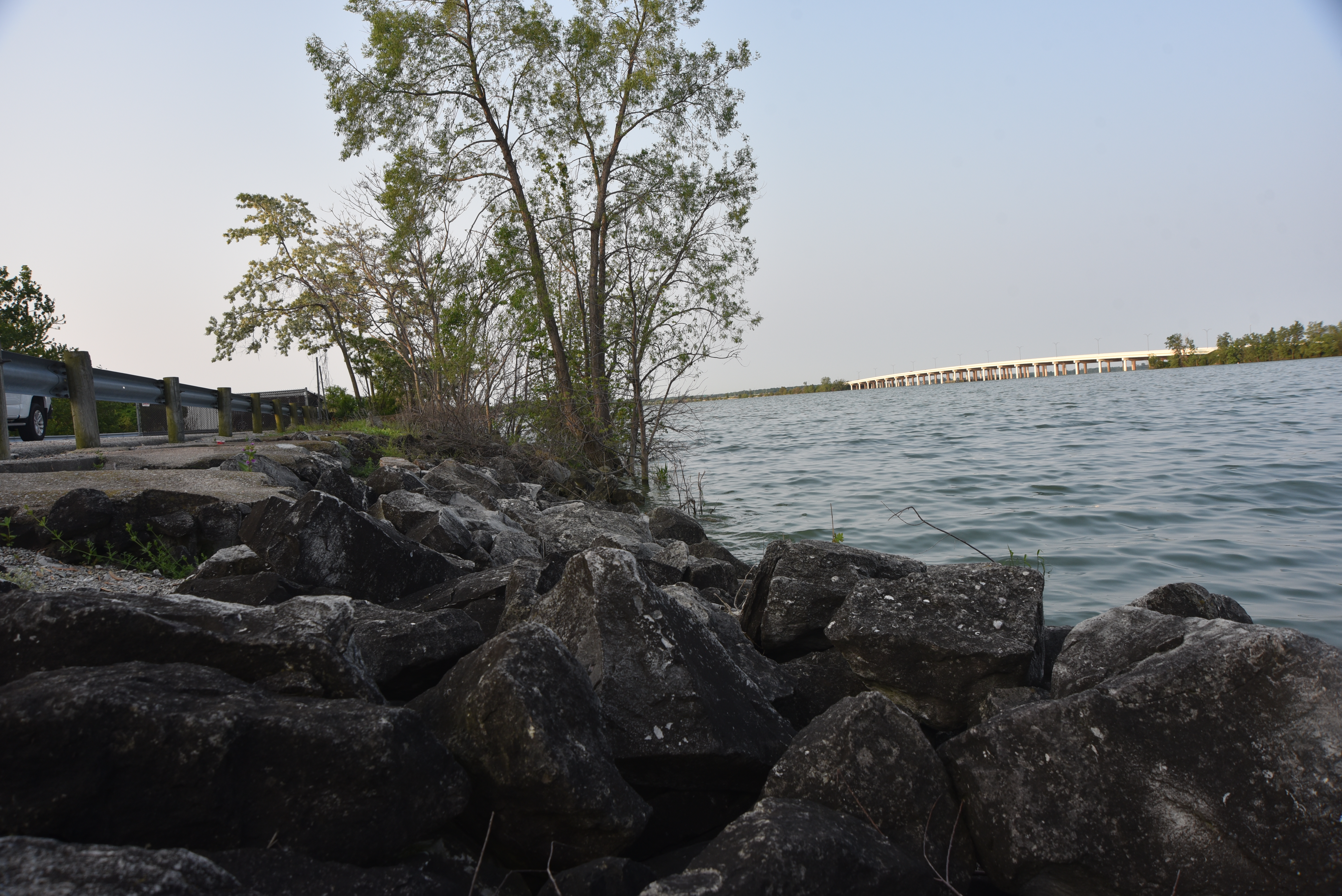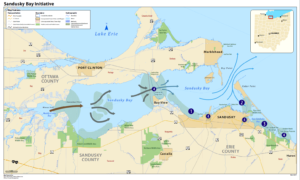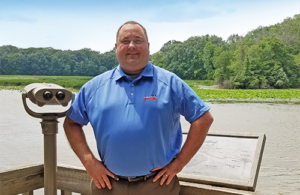
The Sandusky Bay is 64 square miles of long, wide, shallow, muddy waters, suffering from months-long harmful algae blooms every year, and over the course of the next decade it’s about to go through a major transformation.
That transformation comes from the Sandusky Bay Initiative, an Ohio Department of Natural Resources program which aims to turn the bay into a cleaner, friendlier body of water for both wildlife and people looking to engage with the wildlife like kayakers and birdwatchers, among others.
“The whole initiative really encompasses a lot of different projects from restoring wetlands and aquatic ecosystems to reducing wave action and improving water clarity,” said Eric Weimer, a fisheries biologist supervisor at the Ohio Division of Wildlife’s Sandusky Fisheries Research Station.
Officials in charge of the ambitious years-long project hope to ultimately send the best possible water into Lake Erie, which means less turbid water with lower amounts of the nutrients which feed harmful algae blooms. The bay drains about 1,800 square miles of mostly agricultural land in northwest Ohio.“We’ve really made a lot of good progress,” said Scudder Mackey, who oversees the Ohio Department of Natural Resources’ Office of Coastal Management. “We’ve secured funding and we’re still finishing off some permitting. When you have new and completely innovative projects, the regulators are more cautious, so on some things we’re taking a bit more time.”
One of the innovations, Mackey explained, includes the re-use of tens of thousands of tons of dredged material the U.S. Army Corps of Engineers produces each year from the shipping channel which runs from the lake into the bay. Ohio law requires that open lake dumping of dredge materials in Lake Erie end in 2020. For decades sediments from Ohio’s major harbors has been disposed of by being transported via barge onto the lake and dumped.
The new projects on the bay will take the dredged materials and create new wetlands with them.
“We call them in-water wetlands,” Mackey explained. “It’s clean material, very fine-grained and that makes it really ideal, very suitable for wetlands. It’s going to be a nature-based approach, less stone and more woody-type debris and degradable materials over time. As the sediment compacts and degrades, the debris provides habitat structure and additional organic material.”
According to Mackey, an array of these new, shallow wetlands will not only help absorb and eliminate nutrient run-off entering Lake Erie, but also be great for fish.
The first projects will be in the bay’s eastern reach, in the Sandusky area, he said. After that there will be work ongoing each year for seven or eight years.
“We’ll construct a cell, then fill it with dredge materials,” then another and another and another, Mackey said. In the end, areas of the bay that were not so visitor-friendly will be perfect for getting on the water and acquainted with nature up-close and personal. A video produced by the Office of Coastal Management offers projected before-and-after views of a few areas in the bay where projects are planned.
Engineering and planning costs were paid for in part by $1 million from Ohio’s Healthy Lake Erie Fund. Funding for the Sandusky Bay Initiative will come from multiple sources and likely include contributions from Governor Mike DeWine’s new H2Ohio Initiative, which could pump up to $900 million into water-related research, restoration and management over a decade. A figure on total expected costs is not yet available.
Great for fish, great for fishing
“In general, (this initiative is) going to provide great opportunities for fish you’d associate with wetland or protected areas,” Weimar said. “Fish like largemouth, crappie, bluegill and potentially even northern pike or muskellunge.”
Northern pike and muskie are massive, toothy predators and rarely caught, in comparison to other sportfish. They can grow to lengths of nearly four feet and five feet, respectively.
Weimer said that while there can be some good fishing in the bay, it’s rather limited when it comes to some of the more prized sportfish.
“There’s not a lot, but there’s a few,” he said of highly-coveted fish like small and largemouth bass and northern pike. “There’s been some research in the wetlands areas and some northern pike have been caught during the spawning season in East Harbor, West Harbor and in Sandusky Bay near Standing Rush Marsh. But with an improvement in habitat we would expect to see more of those fish and hopefully make them a more common catch for anglers.”
Weimer said having enthusiastic partners involved in the planning process has been a good thing.
“One of the nicest things about this is that the City of Sandusky has been very interested and helpful in moving this along,” he said. “They’re interested not only in the effect on the city itself, but the surrounding area and they realize that these improvements all trickle down.”
City of Sandusky stands to reap big rewards
At 22 miles in length, the bay spreads from the mouth of the Sandusky River and a handful of smaller tributaries all the way to Lake Erie. At its headwaters, the bay is remote and wild, home to a handful of waterfowl hunting clubs, large populations of wading birds and snapping turtles and a first-class bald eagle rookery.
By the time it reaches Lake Erie, it’s quite the urban water; homes, cottages, trailers, bridges, a massive amusement park, coal docks, rail yards and downtown Sandusky crowd its banks.
Aaron Klein, the director of public works in Sandusky, is enthusiastic about the bay and its coming changes. While the initiative will eventually affect wide swaths of in-water wetlands in the central and western bay areas, its first focus will be in the more urban waterfront areas.
“These projects have the ability to improve the quality of life for our residents and visitors,” he said. “Revitalizing the waterfront for recreational activities such as kayaking, paddle sports, fishing and birding speak very loudly to the overall public.”
Klein, whose background is in environmental engineering and project management, said that including a wide array of participants in the planning is a key factor in making it a success. That includes academics, state and federal agencies, scientists, tourists, elected officials, property owners and businesses, among others.
“Our city commissioners are very progressive and are extremely supportive of anything that will improve water quality and the environment, especially if it can have an economic impact while placing Sandusky as a leader in the region,” Klein said. “One of our goals is to attract wildlife and create recreational activities. Along the narrow paths designed for paddle sports, we’ll be creating fish spawning areas and using native plant species to attract birds.”
If all goes as planned, downtown Sandusky will be just steps away from lush waters rife with birds, fish, turtles and other wildlife who either are passing through or have made the marshes, wetlands and waterways their permanent homes.
Even drivers spending just two minutes crossing the Route 2 bridge over the bay will see its eventual results.
“One of the bridge openings, part of that will be where water will be able to flow back and forth through the wetland, where east Sandusky Bay and west Sandusky Bay meet,” Mackey said. “We’re not shutting anything off there, but we’re moving some of the water through this complex not only promoting fish movement in and out of the system, but also trapping some of the sediments and process nutrients as well. There are multiple benefits we’re designing for.
Build it and they will come
Bryan Edwards is director of marketing at Lake Erie Shores and Islands—Erie and Ottawa counties’ tourism agency—and he couldn’t be happier at the prospect of nearly a decade of wetlands construction in the area.
“When most people think of wetlands and marshes they think of the ecosystem, but figures were just released that state more than 100 million people go hunting, fishing and nature watching, like birding. So by establishing and re-establishing these areas, they’re perfect for fish breeding and birds and wildlife. I believe it will have a huge impact on tourism not just here in Sandusky but in the entire region,” he said, pointing out that a number of paddle sports and fishing access points will be created, including along the long causeway to Cedar Point.Edwards, who grew up on the bay, said seeing natural wetlands return in the area will only enhance visitor experiences.
“This area is known for boating and water-related activities, and so this will be great for tourism and a great benefit for all locals as well.”
Mackey said enhanced monitoring work and data collection has been ongoing in anticipation of the project and will continue throughout and after completion to gauge whether the desired effects of the initiative are obtained.
“We want to make sure that what we do we do right and that’s everything is well-designed,” Mackey said. “It’s going to take a little time to get there, but I really think we’re definitely on the right path.”
5 Comments
-
Yikes….Sandusky should be renamed… And wiped from the “history” books. Having his name associated to ANYTHING IS A TRAVESTY
-
WTF are you talking about?
-
-
My family has been enjoying their weekends and vacations on Sandusky Bay since 1940. This is a magic place for all of us. From our grandparents, our parents, on to our children (known as the cousins.}
The Bay is a magic place for everyone that a chance to be part of it.
Please keep it as it is. The Bay should stay as it is.
-
More wetlands, yes, and then improve Bay Bridge by removing the ugly, view-constricting concrete barriers that block the view of motorists as they cross the high point of the bridge. I dont know of any bridge that purposely impedes the expansive view it naturally provides.
-
sounds to me like the already shallow bay is going to get shallower. Even more difficult to navigate in a boat bigger than a kayak. This will not help tourism or property values. Do you really want to trade thousands of boaters using the marinas, gas docks, etc., for a few hundred kayaks, that can already use the bay, no problem? And there are massive shallow wetlands in the far east and south ends of the bay already. Stop the agrigultural runoff instead of destroying the bay. This is just an excuse to get rid of the dredged material because they can no longer dump it in the lake.






